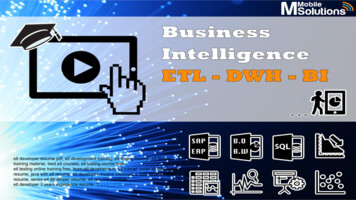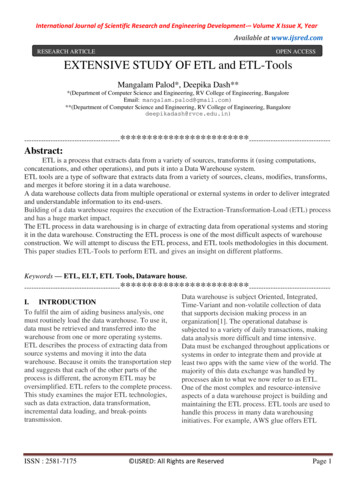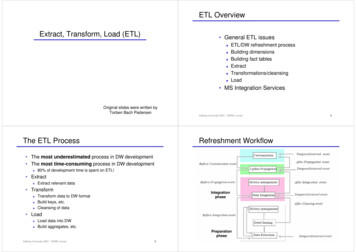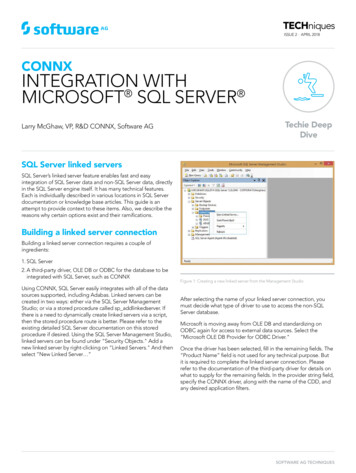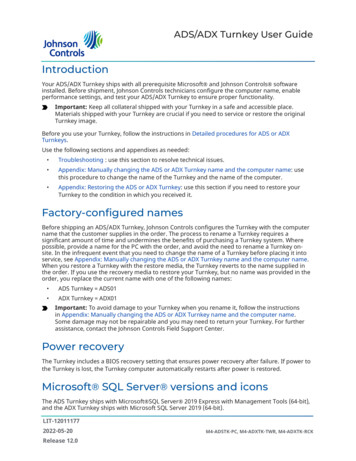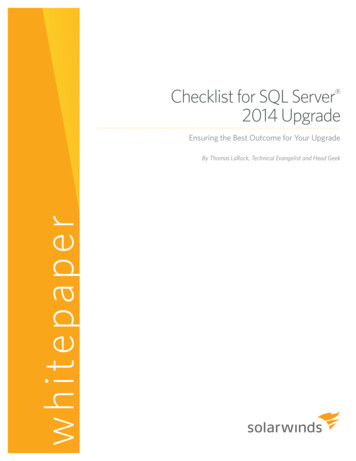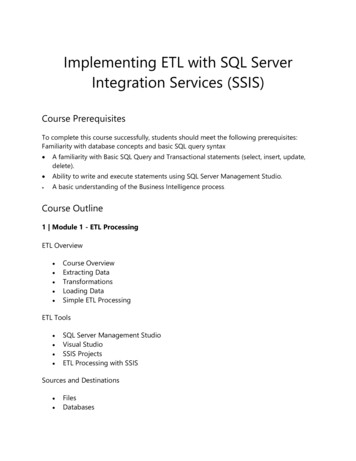
Transcription
Implementing ETL with SQL ServerIntegration Services (SSIS)Course PrerequisitesTo complete this course successfully, students should meet the following prerequisites:Familiarity with database concepts and basic SQL query syntax A familiarity with Basic SQL Query and Transactional statements (select, insert, update,delete). Ability to write and execute statements using SQL Server Management Studio. A basic understanding of the Business Intelligence process.Course Outline1 Module 1 - ETL ProcessingETL Overview Course OverviewExtracting DataTransformationsLoading DataSimple ETL ProcessingETL Tools SQL Server Management StudioVisual StudioSSIS ProjectsETL Processing with SSISSources and Destinations FilesDatabases
Web ServicesSources and DestinationsCreating an Example Database Creating an Example DatabaseCreating the Source DatabaseCreating the Destination DatabaseModule Assessment SimulationModule Summary2 Module 2 - ETL with SQL ProgrammingETL Scripts OverviewFlush and FillIncremental LoadingTransformations Name and Datatype TransformationsTransforming data valuesHandling Date and Time DataHandling NullsIncremental Loading with SQL MergeImplementing ETL with SQL Using the Query DesignerCreating ETL Views and Stored ProceduresCreating a SQL ETL ScriptModule Assessment SimulationModule Summary
3 Module 3 - ETL Processing with SSISCreating SSIS Projects OverviewSSIS PackagesProgramming SSIS Packages Sequence Containers and Precedent ConstraintsOutlining an ETL process with SSISConfiguring connectionsExecute SQL tasksUsing Stored Procedures from SSISImplementing SSIS Packages Resetting your Destination DatabaseTesting an SSIS packageModule Assessment SimulationModule Summary4 Module 4 - SSIS Data Flows Creating Data FlowsOverviewSSIS Data Sources, Transformations, and Destinations Data Flow PathsData ViewersData Flow TransformationsSort and Data ConversionAggregate and Derived ColumnsLookupsMerge, Merge Join, and Union AllPerformance OptionsTuning Data Sources
Staging DatabasesModule Assessment Module SummaryModule Assessment5 Module 5 - Deployment and TroubleshootingTesting Event HandlersLogging SSIS packagesTroubleshootingDeployment Deploying to the NetworkDeploying to SQL ServerETL AutomationModule Assessment SimulationModule Summary6 Module 6 - Final Course SummaryFinal Exam
Expected EffortEach week, you should expect to spend an average 4-5 hours on the course, including: Viewing the lecture videos and demonstrations. Further reading. Trying the labs. Completing module assessments (see below).Coursework and GradingThis course includes coursework, some of which is graded. Each module in the courseincludes knowledge check or lab based knowledge check questions. Modules 2, 3 and 4contain labs that must be completed to be able to answer the knowledge checks in whichyou must answer all questions. Additionally, at the end of the course you must complete afinal exam.The module assessments are combined for a value of 50% of the total grading for thecourse, and the final exam accounts for the remaining 50%. You must achieve an overallscore of 70% or more to pass this course.In the module assessments, you have two attempts at each question. In the final exam, youare restricted to one attempt per question.DiscussionWe encourage all students to submit questions, observations, and comments in theDiscussion section. If you have any issues while working on the course, check here first –your fellow students may have already found a resolution!Please remember that the discussion forum is open to all students and staff, and while welove to see passionate engagement, abusive or inflammatory behavior will not be tolerated.Due to the volume of students attending this course, it will not be possible for the coursestaff to answer every question individually. You should still post questions however, becausein many cases, your fellow students may be able to help.
Implementing ETL with SQL Server Integration Services (SSIS) Course Prerequisites To complete this course successfully, students should meet the following prerequisites: Familiarity with database concepts and basic SQL query syntax A familiarity with Basic SQL Query and Transactional statements (select, insert, update, delete).
